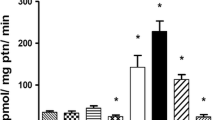Abstract
Differences in Zn-induced levels of hepatic metallothionein (MT) in inbred strains of the mouse are described. Three low-producing strains, C57BL/6, C57BL/10, and NIH, are identified, while C3H and CBA display the highest levels of hepatic MT following Zn treatment. These interstrain differences affect not only the level of MT protein, but also the amount of MT-bound Zn and the total hepatic Zn concentration. Both MT isoforms are equally affected. A similar interstrain difference following Cu treatment is present in C3H and C57BL/6. The origin of these interstrain differences is discussed.
Similar content being viewed by others
References
Bremner, I., and Young, B. W. (1976). Isolation of (copper, zinc)-thioneins from the livers of copper-injected rats.Biochem. J. 157517.
Bremner, I., Hoekstra, W. G., Davies, N. T., and Young, B. W. (1978). Effect of zinc status of rats on the synthesis and degradation of copper-induced metallothioneins.Biochem. J. 174883.
Cain, K., and Holt, D. E. (1979). Metallothionein degradation: Metal composition as a controlling factor.Chem.-Biol. Interact. 2891.
Chen, R. W., Whanger, P. D., and Weswig, P. H. (1975). Biological function of metallothionein. I. Synthesis and degradation of rat liver metallothionein.Biochem. Med. 1295.
Day, F. A., Funk, A. E., and Brady, F. O. (1984).In vivo andex vivo displacement of Zn from metallothionein by cadmium and by mercury.Chem.-Biol. Interact. 50159.
Feldman, S. L., Squibb, K. S., and Cousins, R. J. (1978). Degradation of cadmium thionein in rat liver and kidney.J. Toxicol. Environ. Hlth. 4805.
Hildebrand, C. E., Enger, M. D., and Tobey, R. A. (1980). Comparative studies on zinc metabolism in cultured Chinese hamster cells with differing metallothionein-induction capacities.Biol. Trace Elem. Res. 2235.
Holt, D., Magos, L., and Webb, M. (1980). The interaction of cadmium-induced rat renal metallothionein with bivalent mercuryin vitro.Chem.-Biol. Interact. 32125.
Hunt, D. M. and Clarke, R. (1983). Metallothionein and the development of mottled disorder in the mouse.Biochem. Genet. 211913.
Hunt, D. M., and Mhlanga, T. (1983). Genetic studies on metallothionein synthesis in the mouse: The induction of metallothionein by cadmium in inbred strains.Biochem. Genet. 21609.
Hunziker, P. E., and Kagi, J. H. R. (1985). Isolation and characterisation of six human hepatic isometallothioneins.Biochem. J. 231375.
Kagi, J. H. R., and Vallee, B. O. (1960). Metallothionein: A cadmium-and zinc-containing protein from equine renal cortex.J. Biol. Chem. 2353460.
Kagi, J. H. R., and Vallee, B. L. (1961). Metallothionein: A cadmium-and zinc-containing protein from equine renal cortex. II Physicochemical properties.J. Biol. Chem. 2362435.
Koizumi, S., Otaki, N., and Kimura, M. (1985). Evidence for more than two metallothionein isoforms in primates.J. Biol. Chem. 2603672.
Margoshes, M., and Vallee, B. L. (1957). A cadmium protein from equine kidney cortex.J. Am. Chem. Soc. 794813.
Nordberg, G. F., Nordberg, M., Piscator, M., and Vesterberg, O. (1972). Separation of two forms of rabbit metallothionein by isoelectric focusing.Biochem. J. 126491.
Piotrowski, J. K., Bolanowska, W., and Sapota, A. (1973). Evaluation of metallothionein content in animal tissues.Acta Biochim. Pol. 20207.
Piscator, M. (1964). On cadmium in normal human kidneys together with a report on the isolation of metallothionein from livers of cadmium-exposed rabbits.Nord. Hyg. Tidskr. 4576.
Quaife, C., Durnam, D., and Mottet, N. K. (1984). Cadmium hypersusceptibility in the C3H mouse liver: Cell specificity and possible role of metallothionein.Toxicol. Appl. Pharmacol. 769.
Sciortino, C. V., Failla, M. L., and Bullis, D. B. (1982). Identification of metallothionein in parenchymal and non-parenchymal liver cells of adult rat.Biochem. J. 204509.
Searle, P. F., Davison, B. L. Stuart, G. W., Wilkie, T. M., Norsedt, G., and Palmiter, R. D. (1984). Regulation linkage and sequence of mouse metallothionein I and II genes.Mol. Cell Biol. 41221.
Seguin, C., and Hamer, D. H. (1987). Regulation in vitro of metallothionein gene binding factors.Science 2351383.
Tsunoo, H., Kino, K., Nakajima, H., Hata, A., Huang, I.-Y., and Yoshida, A. (1978). Mouse liver metallothioneins. Purification, molecular weight, amino acid composition and metal content.J. Biol. Chem. 2534172.
Whanger, P. D., Oh, S. H., and Deagen, J. T. (1981). Ovine and bovine metallothioneins: Accumulation and depletion of zinc in various tissues.J. Nutr. 1111196.
Winge, D. R., Nielson, K. B., Zeikus, R. D., and Gray, W. R. (1984). Structural characterization of the isoforms of neonatal and adult rat metallothionein.J. Biol. Chem. 25911419.
Yagle, M. K., and Palmiter, R. D. (1985). Coordinate regulation of mouse metallothionein I and II genes by heavy metals and glucocorticoids.Mol. Cell Biol. 5291.
Author information
Authors and Affiliations
Rights and permissions
About this article
Cite this article
Farr, C., Hunt, D.M. Genetic differences in zinc and copper induction of liver metallothionein in inbred strains of the mouse. Biochem Genet 27, 199–217 (1989). https://doi.org/10.1007/PL00020155
Received:
Revised:
Issue Date:
DOI: https://doi.org/10.1007/PL00020155




